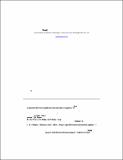Por favor, use este identificador para citar o enlazar a este item:
http://hdl.handle.net/10261/134726COMPARTIR / EXPORTAR:
 SHARE SHARE
 CORE
BASE CORE
BASE
|
|
| Visualizar otros formatos: MARC | Dublin Core | RDF | ORE | MODS | METS | DIDL | DATACITE | |

| Título: | Evaluation of 100G DP-QPSK long-haul transmission performance using second order co-pumped Raman laser based amplification |
Autor: | Tan, Mingming; Rosa, Pawel CSIC ORCID; Le, S.T.; Phillips, I.D.; Harper, P. | Fecha de publicación: | 4-ago-2015 | Editor: | Optical Society of America | Citación: | Optics Express 23: 22181- 22189 (2015) | Resumen: | We present, for the first time, a detailed investigation of the impact of second order co-propagating Raman pumping on long-haul 100G WDM DP-QPSK coherent transmission of up to 7082 km using Raman fibre laser based configurations. Signal power and noise distributions along the fibre for each pumping scheme were characterised both numerically and experimentally. Based on these pumping schemes, the Q factor penalties versus co-pump power ratios were experimentally measured and quantified. A significant Q factor penalty of up to 4.15 dB was observed after 1666 km using symmetric bidirectional pumping, compared with counter-pumping only. Our results show that whilst using co-pumping minimises the intracavity signal power variation and amplification noise, the Q factor penalty with co-pumping was too great for any advantage to be seen. The relative intensity noise (RIN) characteristics of the induced fibre laser and the output signal, and the intra-cavity RF spectra of the fibre laser are also presented. We attribute the Q factor degradation to RIN induced penalty due to RIN being transferred from the first order fibre laser and second order co-pump to the signal. More importantly, there were two different fibre lasing regimes contributing to the amplification. It was random distributed feedback lasing when using counter-pumping only and conventional Fabry-Perot cavity lasing when using all bidirectional pumping schemes. This also results in significantly different performances due to different laser cavity lengths for these two classes of laser. © 2015 Optical Society of America | Descripción: | 9 págs.; 6 figs.; OCIS codes: (060.1660) Coherent communications; (060.2320) Fiber optics amplifiers and oscillators; (190.5650) Raman effect. | Versión del editor: | http://dx.doi.org/10.1364/OE.23.022181 | URI: | http://hdl.handle.net/10261/134726 | DOI: | 10.1364/OE.23.022181 | Identificadores: | doi: 10.1364/OE.23.022181 issn: 1094-4087 |
| Aparece en las colecciones: | (CFMAC-IO) Artículos |
Ficheros en este ítem:
| Fichero | Descripción | Tamaño | Formato | |
|---|---|---|---|---|
| Evualuation.pdf | 955,26 kB | Adobe PDF |  Visualizar/Abrir |
CORE Recommender
SCOPUSTM
Citations
54
checked on 08-may-2024
WEB OF SCIENCETM
Citations
42
checked on 29-feb-2024
Page view(s)
266
checked on 12-may-2024
Download(s)
253
checked on 12-may-2024
Google ScholarTM
Check
Altmetric
Altmetric
NOTA: Los ítems de Digital.CSIC están protegidos por copyright, con todos los derechos reservados, a menos que se indique lo contrario.
